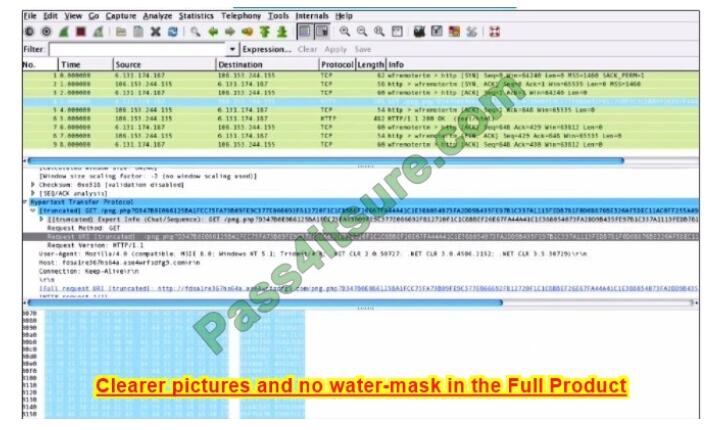Pass4itsure has started for many years in providing the IT certification Cisco 300-165 dumps Implementing Cisco Data Center 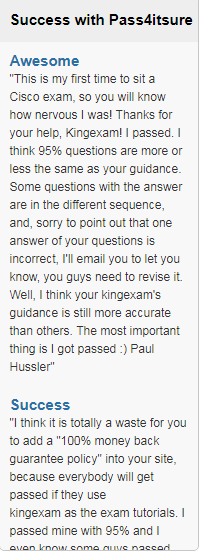 Infrastructure exam preparation materials. Implementing Cisco Data Center Infrastructure (DCII 300-165) is a qualifying exam that Pass4itsure offers free demo for 300-165 exam (CCNP Data Center – Implementing Cisco Data Center Infrastructure). Our 300-165 exam collection helped more than 10696+ candidates pass exams including 60% get a good passing score.
Infrastructure exam preparation materials. Implementing Cisco Data Center Infrastructure (DCII 300-165) is a qualifying exam that Pass4itsure offers free demo for 300-165 exam (CCNP Data Center – Implementing Cisco Data Center Infrastructure). Our 300-165 exam collection helped more than 10696+ candidates pass exams including 60% get a good passing score.
6000+ Exam Q&As
6000+ Free Demo
98% Pass Rate
100% Money Back Guarantee
365 Days Free Update
5 Years Working Experience
Instant Download After Purchase
100% Money Back Guarantee
365 Days Free Update
7000+ Satisfied Customer
Buy pass4itsure Cisco 300-165 dumps exam, real Cisco https://www.pass4itsure.com/300-165.html dumps try free Youtube will be more popular, We help you pass Implementing Cisco Data Center Infrastructure.
To Get More Information About Cisco 300-165 Dumps Exam Go Here(1-14)
QUESTION 1
Which two issues explain why a packet is not being routed as desired in a policy-based routing configuration? (Choose two.)
A. The next hop that is configured in the route map has a higher metric than the default next hop.
B. The route map is not applied to the egress interface.
C. The next hop that is configured in the route map is not in the global routing table.
D. The route map is not applied to the ingress interface.
E. The next hop that is configured in the route map has a lower metric than the default next hop.
300-165 exam Correct Answer: CE
Explanation
Explanation/Reference:
The next hop that is configured in the route map is not in the global routing table then the packet will not be forwarded as desired. The next hop that is configured in the route map has a higher metric than the default next hop.
QUESTION 2
In policy-based routing, which action is taken for packets that do not match any of the route-map statements?
A. forwarded after the egress queue empties on the outbound interface
B. forwarded using the last statement in the route map
C. forwarded using the closest matching route-map statement
D. forwarded using destination-based routing
Correct Answer: D
Explanation
Explanation/Reference:
QUESTION 3
When you configure LISP, which two components must be configured at the site edge? (Choose two.)
A. AED
B. ELAN
C. ITR
D. EOBC
E. ETR
300-165 dumps Correct Answer: CE
Explanation
Explanation/Reference:
QUESTION 4
Which command should you ran to distribute NTP configuration changes by using Cisco Fabric Services?
A. ntp distribute
B. ntp server 1.2.3.4
C. ntp commit
D. ntp authenticate
Correct Answer: A
Explanation
Explanation/Reference:
QUESTION 5
Refer to the exhibit.
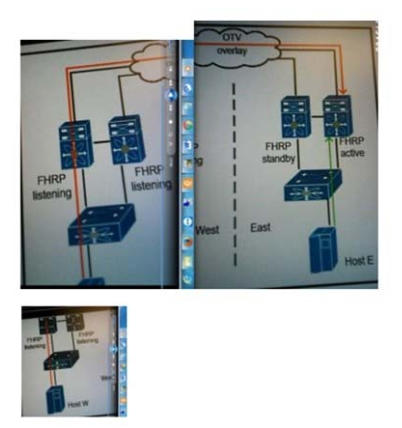
You have a suboptimal outbound routing issue in the datacenter. Which two options you can use to resolve the issue? (Choose two)
A. On the OTV VDC, configure an OTV MAC route filter that prevent the virtual FHRP MAC address forwarded on the overlay
B. On the OTV edge devices, configure a VACL that prevents FHRP hellos from being forwarded
C. Configure the same FHRP priority on all the OTV edge devices in both sites
D. Remove the VLAN from which FHRP hellos are sent from the extended VLAN range
E. On the OTV edge devices, configure an IP ACL that prevents hosts from reaching the FHRP master router on the other site
300-165 pdf Correct Answer: BD
Explanation
QUESTION 6
You plan to configure authentication for OSPF. In which mode should you configure OSPF authentication to use a specific key chain?
A. router ospf
B. global configuration
C. vPC
D. interface
Correct Answer: D
Explanation
Explanation/Reference:
QUESTION 7
Which two Nexus family line cards allow the configuration of features regarding LISP, OTV and MPLS? (Choose two.)
A. B1
B. F3
C. F2
D. F1
E. M2
300-165 vce Correct Answer: BC
Explanation
QUESTION 8
What are two ways to configure the switch ID for Cisco FabricPath? (Choose two.)
A. manually by using the vPC domain configuration
B. manually by using global configuration mode
C. dynamically by using the POAP protocol
D. dynamically by using the DRAP protocol
E. dynamically by using the SNMPv2 protocol
Correct Answer: AB
Explanation
QUESTION 9
Refer to the exhibit.
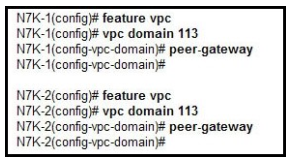
What is the consequence of configuring peer-gateway on the two vPC peers N7K-1 and N7K-2?
A. Nothing, this is the standard vPC configuration to make the feature work.
B. The downstream device detects only one of the vPC peers as its gateway.
C. The downstream device can use DMAC of N7K-1 on the link to N7K-2, and N7K-2 forwards the packet.
D. This configuration enables the downstream device to use DHCP to obtain its default gateway.
300-165 exam Correct Answer: C
Explanation
Explanation/Reference:
Beginning with Cisco NX-OS 4.2(1), you can configure vPC peer devices to act as the gateway even for packets that are destined to the vPC peer device’s MAC address. Use the peer-gateway command to configure this feature. Some network-attached storage (NAS) devices or load-balancers may have features aimed to optimize the performances of particular applications. Essentially these features avoid performing a routing-table lookup when responding to a request that
originated form a host not locally attached to the same subnet. Such devices may reply to traffic using the MAC address of the sender Cisco Nexus 7000 device rather than the common HSRP gateway. Such behavior is non-complaint with some basic Ethernet RFC standards. Packets reaching a vPC device for the non local router MAC address are sent across the peer-link and could be dropped by the built in vPC loop avoidance mechanism if the final destination is behind another vPC. The vPC peer-gateway capability allows a vPC switch to act as the active gateway for packets that are addressed to the router MAC address of the vPC peer. This feature enables local forwarding of such packets without the need to cross the vPC peer-link. In this scenario, the feature optimizes use of the peer-link and avoids potential traffic loss. Configuring the peer-gateway feature needs to be done on both primary and secondary vPC peers and is non-disruptive to the operations of the device or to the vPC traffic. The vPC peer-gateway feature can be configured globally under the vPC domain submode. When enabling this feature it is also required to disable IP redirects on all interface VLANs mapped over a vPC VLAN to avoid generation of IP redirect messages for packets switched through the peer gateway router. When the feature is enabled in the vPC domain, the user is notified of such a requirement through an appropriate message. Packets arriving at the peer-gateway vPC device will have their TTL decremented, so packets carrying TTL = 1 may be dropped in transit due to TTL expire. This needs to be
taken into account when the peer-gateway feature is enabled and particular network protocols sourcing packets with TTL = 1 operate on a vPC VLAN.
QUESTION 10
You have a Cisco Nexus 5000 Series switch. Port security is configured to use sticky learning. Where are the secured MAC addresses stored?
A. the running configuration
B. the startup configuration
C. NVRAM
D. RAM
300-165 dumps Correct Answer: C
Explanation
Explanation/Reference:
QUESTION 11
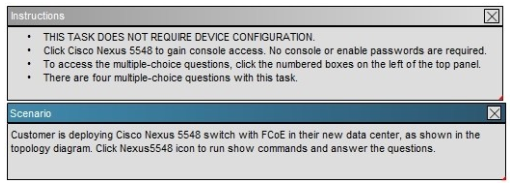
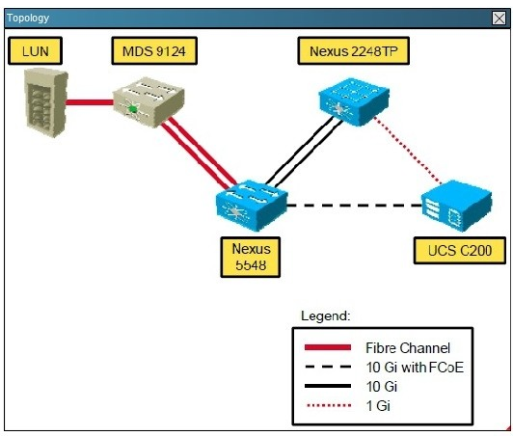
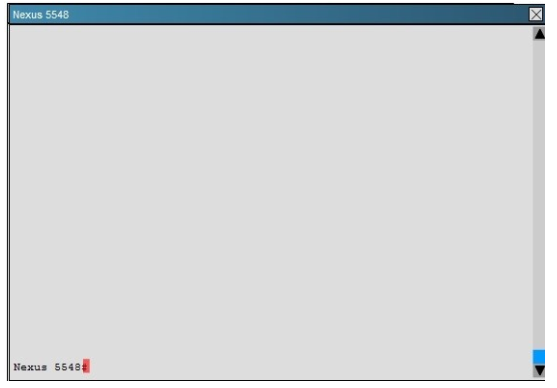
Ethernet interface 1/5 on Cisco Nexus 5548 is connected to Cisco UCS C220 rack server. What is the status of Ethernet 1/5 interface for FCoE functionality?
A. Interface reset on Ethernet 1/5 is preventing the FCoE connection from coming up
B. MTU size of 1500 on Ethernet interface 1/5 needs to be changed for FCoE to come UP
C. Cisco Nexus 5548 needs a layer 3 daughter card for FCoE to come UP on the Ethernet interface 1/5
D. Ethernet interface 1/5 is operational for FCoE and the status is UP
Correct Answer: D
Explanation
QUESTION 12
Which statement about enhanced zoning on Cisco Multilayer Director Switches are true?
A. It allows partial zone set changes to be distributed without having to activate a zone set.
B. Enhanced zoning is compatible with IVR.
C. Zone changes can scheduled with a CRON job.
D. More than one zone set can be active with enhanced zoning.
300-165 pdf Correct Answer: A
Explanation
Explanation/Reference:
Enhanced zoning implements changes to the zoning database and distributes it without reactivation. Distribution of zone sets without activation avoids hardware changes for hard zoning in the switches.
QUESTION 13
What are two prerequisite to running the Smart Call Home feature on a Cisco nexus 6000 series switch? (Select two)
A. The switch must have SMTP access to an email server
B. The switch must have public management IP address
C. The switch must have SMTP access to a Cisco.com email server
D. The switch must have an active service contract
E. The switch must be configured to use an email address from the @cisco.com
Correct Answer: AD
Explanation
Explanation/Reference:
You must have e-mail server connectivity.
You must have access to contact name (SNMP server contact), phone, and street address information.
You must have IP connectivity between the switch and the e-mail server. You must have an active service contract for the device that you are configuring.
QUESTION 14
Drag the security description on the left to the appropriate security feature on the right.
Select and Place:
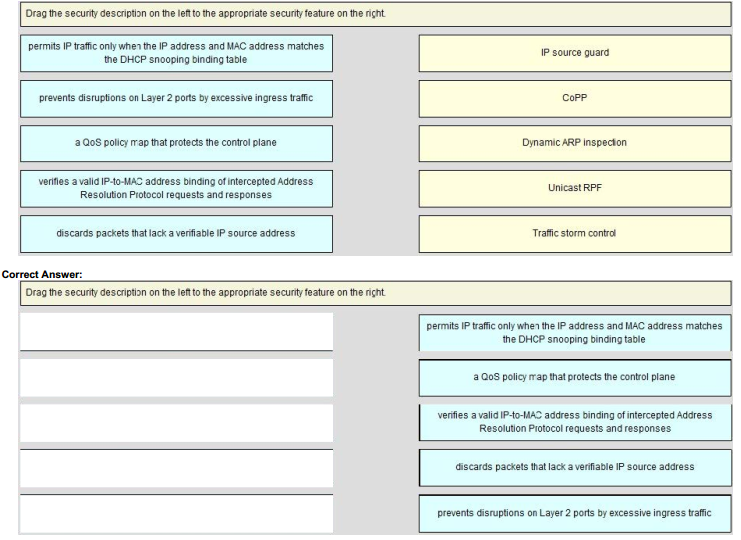
Explanation/Reference:
IP Source guard: IP Source Guard provides source IP address filtering on a Layer 2 port to prevent a malicious host from impersonating a legitimate host by assuming the legitimate host’s IP address. The feature uses dynamic DHCP snooping and static IP source binding to match IP addresses to hosts on untrusted Layer 2 access ports. Initially, all IP traffic on the protected port is blocked except for DHCP packets. After a client receives an IP address from the DHCP server, or after static IP source binding is configured by the administrator, all traffic with that IP source address is permitted from that client. Traffic from other hosts is denied. This filtering limits a host’s ability to attack the network by claiming a neighbor host’s IP address. IP Source Guard is a port-based feature that automatically creates an implicit port access control list (PACL).
CoPP: Control Plane Policing (CoPP) introduced the concept of early rate-limiting protocol specific traffic destined to the processor by applying QoS policies to the aggregate controlplane interface. Control Plane Protection extends this control plane functionality by providing three additional control-plane subinterfaces under the top-level (aggregate) control-plane interface. Each subinterface receives and processes a specific type of control-plane traffic. Dynamic Arp Inspection: Dynamic ARP inspection is a security feature that validates ARP packets in a network. It intercepts, logs, and discards ARP packets
with invalid IP-to-MAC address bindings. This capability protects the network from certain man-in-the-middle attacks.
Dynamic ARP inspection ensures that only valid ARP requests and responses are relayed. The switch performs these activities: Intercepts all ARP requests and responses on untrusted ports Verifies that each of these intercepted packets has a valid IP-to-MAC address binding before updating the local ARP cache or before forwarding the packet to the appropriate destination
Drops invalid ARP packets
Unicast RPF: The Unicast RPF feature reduces problems that are caused by the introduction of malformed or forged (spoofed) IP source addresses into a network by discarding IP packets that lack a verifiable IP source address. For example, a number of common types of Denial-of-Service (DoS) attacks, including Smurf and Tribal Flood Network (TFN) attacks, can take advantage of forged or rapidly changing source IP addresses to allow attackers to thwart efforts to locate or filter the attacks. Unicast RPF deflects attacks by forwarding only the packets that have source addresses that are valid and consistent with the IP routing table. When you enable Unicast RPF on an interface, the device examines all ingress packets received on that interface to ensure that the source address and source interface appear in the routing table and match the interface on which the packet was received. This examination of source addresses relies on the Forwarding Information Base (FIB).
Traffic Storm Control: A traffic storm occurs when packets flood the LAN, creating excessive traffic and degrading network performance. You can use the traffic storm control feature to prevent disruptions on Layer 2 ports by a broadcast, multicast, or unicast traffic storm on physical interfaces.
Traffic storm control (also called traffic suppression) allows you to monitor the levels of the incoming broadcast, multicast, and unicast traffic over a 1-second interval. During this interval, the traffic level, which is a percentage of the total available bandwidth of the port, is compared with the traffic storm control level that you configured. When the ingress traffic reaches the traffic storm control level that is configured on the port, traffic storm control drops the traffic until the interval ends.
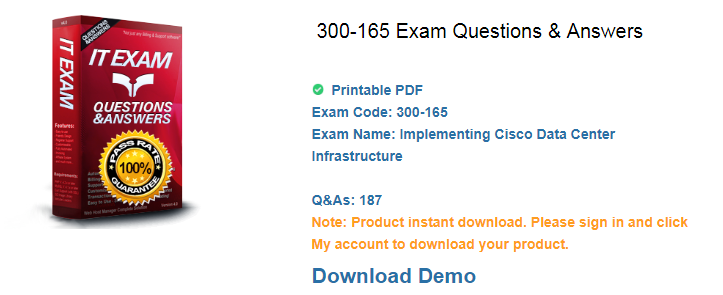
[2018 New Pass4itsure 300-165 PDF Dumps Version From Google Drive]: https://drive.google.com/open?id=0BwxjZr-ZDwwWeTBEWVNsUmFmOEU
[2018 New Pass4itsure 210-060 PDF Dumps Version From Google Drive]: https://drive.google.com/open?id=0BwxjZr-ZDwwWNmlXYjFDT0t3UWc
The Pass4itsure 300-165: Implementing Cisco Data Center Infrastructure practice test is designed to help candidates prepare for and pass the Cisco 300-165 exam. If you do not pass the Cisco CCNP 300-165 dumps exam (CCNP Data Center – Implementing Cisco Data Center Infrastructure) on your first attempt using our Pass4itsure testing engine, we will give you a FULL REFUND of your purchasing fee. Based on recent years’ data our 300-165 passing rate is up to 98.4%.
pass4itsure’s products are developed by a lot of experienced IT specialists using their wealth of knowledge and experience to do research for IT certification exams. A part of candidates say that our 300-165 exam collection has nearly 90% similarity with the real test questions. So if you participate in Cisco certification 300-165 exam, please choose our pass4itsure’s products, pass4itsure can not only provide you a wide coverage and good quality exam information to guarantee you to let you be ready to face this very professional exam but also help you pass Cisco certification https://www.pass4itsure.com/300-165.html dumps exam to get the certification.
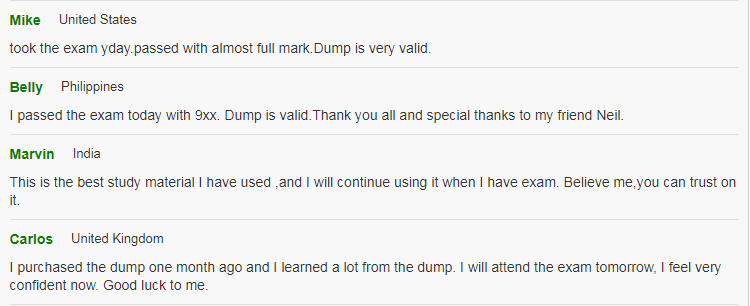
Do you maintain 100% Guarantee on Pass4itsure.com products?
Yes. Our PDF of 300-165 exam is designed to ensure everything which you need to pass your exam successfully. At Pass4itsure.com, we have a completely customer oriented policy. In most cases 300-165 dumps exam collection may include 80% or so of the real test questions. We invite the rich experience and expert knowledge of professionals from the IT certification industry to guarantee the PDF details precisely and logically. Our customers’ time is a precious concern for us. This requires us to provide you the products that can be utilized most efficiently.
Do you offer free after-sale services?
Yes. We provide 7/24 customer help and information on a wide range of issues. Our service is professional and confidential and your issues will be replied within 12 hous. If you want to get a wonderful pass mark you may need to pay more attention on studying 300-165 dumps. If you master all questions and answers you will get 80% at least. Feel free to send us any questions and we always try our best to keeping our Customers Satisfied.
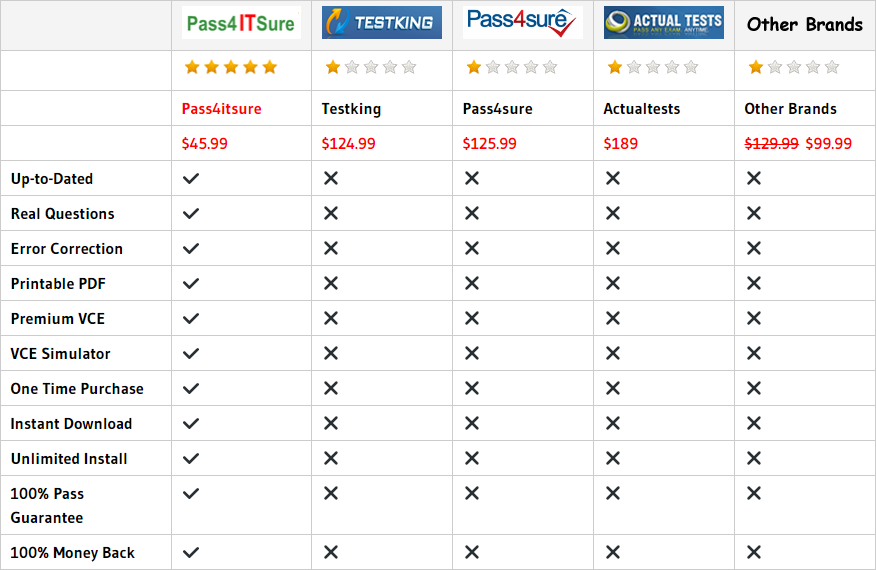
The Cisco 300-165 dumps questions and answers in pass4itsure that we have, is the most reliable guide for Cisco CCNP Data Center certification exams from pass4itsure. We guarantee all customers can 100% pass exam for sure. It is the most reliable Cisco 300-165 exam source of Cisco success and a large number of successful candidates have shown a lot of faith in our Cisco 300-165 dumps pass4itsure question and answers in pass4itsure.
Pass4itsure Cisco 300-165 Dumps Exam Youtube Free Online Test Here: https://youtu.be/_pRVAtLd2XY

